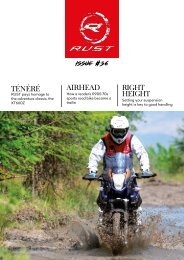RUST magazine: RUST#39
FANTIC CABELLERO – RUST gets a first ride on two of Fantic’s beautiful new street scramblers MOJAVE – JB got to ride the high desert during his recent visit to California, it was too pretty not to share… LONG TERMERS – RUST’s Suzuki and Husqvarna long termers have been hitting the trails – and splashing through lots of water it would seem all this plus, of course, a little more
FANTIC CABELLERO – RUST gets a first ride on two of Fantic’s beautiful new street scramblers
MOJAVE – JB got to ride the high desert during his recent visit to California, it was too pretty not to share…
LONG TERMERS – RUST’s Suzuki and Husqvarna long termers have been hitting the trails – and splashing through lots of water it would seem
all this plus, of course, a little more
Create successful ePaper yourself
Turn your PDF publications into a flip-book with our unique Google optimized e-Paper software.
technical<br />
w<br />
clicks. This will give you an instant<br />
indication if the previous setting was<br />
too firm. Continue to go softer until<br />
the fork is obviously hanging down<br />
in the stroke, and has become mushy<br />
feeling. Go back stiffer two clicks at a<br />
time until you arrive at a best setting.<br />
Now do the same on your rebound.<br />
This is where you will notice big<br />
changes in how the bike will drive<br />
through successive rock impacts. In<br />
general, the faster your rebound the<br />
quicker the fork will ‘reset’. When you<br />
have gone too soft/fast on rebound<br />
the sensation you will feel is one of<br />
the bars ‘springing back’ at you. This is<br />
the indication that you have reached<br />
the end of the adjustment range, now<br />
go back stiffer a couple clicks at a time<br />
until the overall feeling of the forks is<br />
one of smooth, controlled movements<br />
that keep the bike feeling balanced,<br />
under control and not diving or<br />
bucking.<br />
Much like the forks, tuning the shock<br />
is very similar, with one exception.<br />
In rocks, you will make most of your<br />
shock compression adjustments with<br />
the high-speed adjuster. The HS is the<br />
circuit that responds to sharp, quick<br />
impacts. As with the fork, when this<br />
adjustment begins to feel mushy, and<br />
the shock hangs down in the stroke<br />
it’s time to go back stiffer until you<br />
are in the sweet spot. I would suggest<br />
adjustments of no more than ¼ turn<br />
either way; most HS adjusters are<br />
sensitive and have a limited effective<br />
range.<br />
24<br />
www.rustsports.com
















